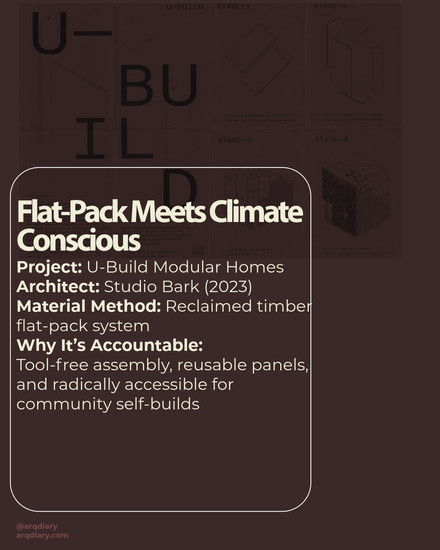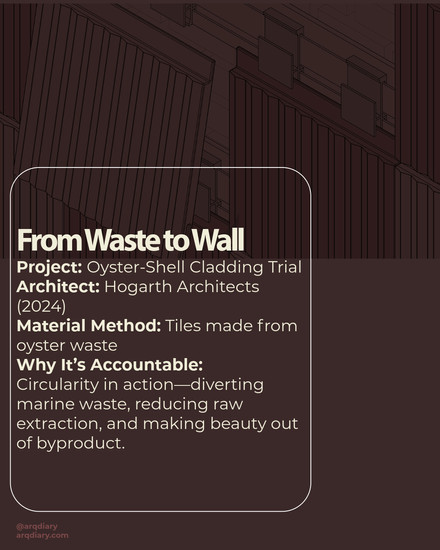Less Carbon, More Accountability
- arqdiary

- Jul 17
- 3 min read
4 Ways Architecture is Getting Real in 2025
From algae bricks to Roman reuse—material innovation is shaping the future of housing design.
If architecture is the stage for our daily lives, then materials are the script—and in 2025, that script is changing fast.
The global conversation around sustainability, culture, and climate justice is pushing architects to rethink the materials we build with—not just for performance, but for meaning. This isn't just about aesthetics anymore. It's about carbon, community, and creativity.
Here are four of the most exciting materiality moves happening right now—from ancient techniques to speculative tech.
🌱 1. Timber, Stone & Rammed Earth Are (Really) Back
Call it the low-carbon renaissance. Architects worldwide are ditching high-emission materials like concrete for carbon-smart, earthy alternatives.
In London, Waugh Thistleton’s Black & White Building (2023) is the UK’s tallest engineered timber office and proves that CLT (cross-laminated timber) can scale up beautifully (Waugh Thistleton, 2023).

In Mallorca, OHLAB's Paseo Mallorca 15 uses load-bearing stone from nearby quarries, merging local heritage with passive cooling (ArchDaily, 2023).


In Thailand, Australia, and South Africa, rammed earth construction is being revived for social and community buildings, like David Chipperfield's Museo Jumex in Mexico and Earth House by Wallmakers in India (Dezeen, 2022).


🧠 Takeaway: Materials aren’t just "stuff"—they’re environmental strategies with emotional weight.
🧪 2. Biomaterials Are Moving Out of the Lab
What if your building could breathe? Or better yet, clean the air while it stands?
Biomaterials like algae bricks, oyster-shell panels, and mycelium insulation are stepping out of research papers and into pilot projects.
In Australia, the University of Queensland’s algae-infused bricks are being trialled for urban heat mitigation (ABC Science, 2024).

In the UK, Hogarth Architects are experimenting with oyster-shell tiles as circular cladding (The Modern House Journal, 2024).

MOGU is testing mycelium-based insulation systems in Italy and Biohm in the UK (MOGU, 2024, Biohm.co.uk).

🌍 Are these scalable yet? Not fully. But they're forcing a shift in mindset—from extractive to regenerative design.
🏛️ 3. The Return of Spolia: Ancient Circularity, Modern Intent
Let’s get historical. The Romans reused materials like champs. Today, this practice—called spolia—is being revived as the OG circular economy move.
The 2022 Venice Biennale featured spolia prominently as a decolonial and climate-forward design gesture (La Biennale, 2022).
Qatar’s 974 Stadium was built using modular shipping containers, designed for complete disassembly and reuse post-World Cup (Dezeen, 2022).
Reclaimed wood façades are being celebrated in projects like Studio Bark’s U-Build system and Re-Use Italy's architectural competitions (Studio Bark, 2023).
🔁 Big picture: Circularity isn’t a trend—it’s ancient wisdom we forgot.
🎭 4. Façades Are Becoming Personal (and Political)
Materials aren’t neutral—they communicate. In 2025, façades are where culture, climate, and identity collide.
In Lisbon, Bak Gordon Arquitectos used metal shutters that reinterpret traditional brise-soleils while optimising solar gain (ArchDaily, 2023).
In Lagos and Nairobi, brick and block are being manipulated into tactile surfaces that speak local vernaculars—seen in Kunlé Adeyemi's Makoko Floating School legacy and Cave_Bureau's anthropological designs (Domus, 2024).
In Bali, Stilt Studios incorporated personalised glass etching and natural ventilation systems into prefab tropical homes (Dezeen, 2023).
👀 Façades aren't just outerwear anymore. They're architectural language.
✨ Why This All Matters
Younger architects, especially students and early-career designers, are hungry for real-world sustainability that goes beyond buzzwords. These innovations show that material choice = design power.
And as we design housing that’s denser, fairer, and more climate-aware, we’ll need to think harder about what we’re cladding our cities with.
🧠 Architecture is not just about form—it’s about matter. And materiality? It’s having a moment.
💬 Let’s Talk
Which of these materials excites you most? Do you see these shifts showing up in your studio work or city?


























Comments